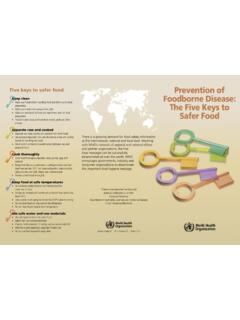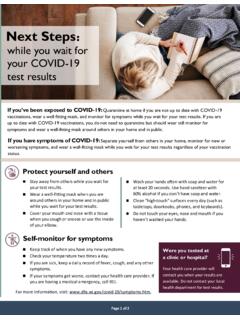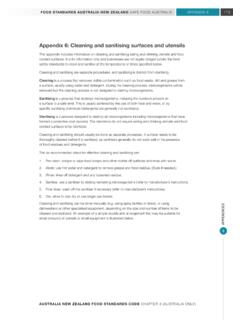Transcription of Neglected Parasitic Infections in the United States ...
1 Center for Global Health Division of Parasitic Diseases and MalariaCS228828A CDC 24/7: Saving Lives. Protecting People. Saving Money through Parasitic Infections in the United StatesNeurocysticercosis Neurocysticercosis is a preventable Parasitic infection caused by larval cysts (enclosed sacs containing the immature stage of a parasite) of the pork tapeworm (Taenia solium). The larval cysts can infect various parts of the body causing a condition known as cysticercosis. Larval cysts in the brain cause a form of cysticercosis called neurocysticercosis which can lead to seizures.
2 Neurocysticercosis, which affects the brain and is the most severe form of the disease, can be fatal. Neurocysticercosis is considered a Neglected Parasitic Infection, one of a group of diseases that results in significant illness among those who are infected and is often poorly understood by health care providers. How people get neurocysticercosis:A person gets neurocysticercosis by swallowing microscopic eggs passed in the feces of a person who has an intestinal pork tapeworm. For example, a person eats undercooked, infected pork and gets a tapeworm infection in the intestines. She passes tapeworm eggs in her feces. If she doesn t wash her hands properly after using the bathroom, she may contaminate food or surfaces with feces containing these eggs.
3 These eggs may be swallowed by another person if they eat contaminated food. Once inside the body, the eggs hatch and become larvae that find their way to the brain. These larvae cause neurocysticercosis. Risk factors for acquiring neurocysticercosis:People are at a higher risk for getting neurocysticercosis by swallowing parasite eggs if they: Have a pork tapeworm infection (this is called autoinfection) Live in a household with someone who has a pork tapeworm Eat food made by someone with a pork tapeworm infection In general, most people in the United States with neurocysticercosis are people who come from regions where the disease is common, including Latin America.
4 Neurocysticercosis is a preventable disease. Good hand washing practices and treating people infected with intestinal tapeworms could drastically reduce the number of new Infections . Why be concerned about neurocysticercosis in the United States ? Neurocysticercosis is a leading cause of adult onset epilepsy worldwide. It is costly to diagnose and treat but entirely are an estimated 1,000 new hospitalizations for neurocysticercosis in the United States each year. Cases are most frequently reported in New York, California, Texas, Oregon, and Illinois. Additionally, neurocysticercosis creates a tremendous economic burden. In a recent study, the average charge of hospitalization due to neurocysticercosis was $37,600, with the most common form of payment being Medicaid ( ).
5 Currently, there is little being done to monitor prevent, or identify and treatneurocysticercosis. Neurocysticercosis is a brain infection that can cause seizures and sometimes death. MRI credit: Courtesy of Medscape Reference com/features/slideshow/neurocysticercosi s/Brain of a patient with neurocysticercosisHealthy brainWhat CDC is doing to address neurocysticercosis:CDC and partners are working to prevent the spread of neurocysticercosis and to find and treat persons who have the disease. Finding and treating people with tapeworm Infections will reduce a preventable cause of seizures, help more people live healthy, productive lives, and lead to lower economic burden on health care.
6 CDC assists state and local health departments to: Advise health care professionals on diagnosing and treating patients with neurocysticercosis Follow up with persons who have neurocysticercosis to figure out how they got the disease and if they or others in their household might have tapeworms Support local public health laboratories to assist with diagnosis of neurocysticercosis and tapeworm Infections Additionally, CDC is developing better diagnostic tests to detect tapeworm infection and cysticercosis. What more needs to be done: Obtain a better estimate of how many people are infected. Understanding where infected people are will help us ensure that they get the right care.
7 Improve healthcare provider understanding of neurocysticercosis so they can better diagnose and treat patients. Teach people what they can do to prevent the disease. Continue to work with States to prevent the spread of neurocysticercosis in the United States . For example, help develop guidelines to ensure that professional food handlers are free of tapeworm infection. For more information on Neglected Parasitic Infections , please visit

















